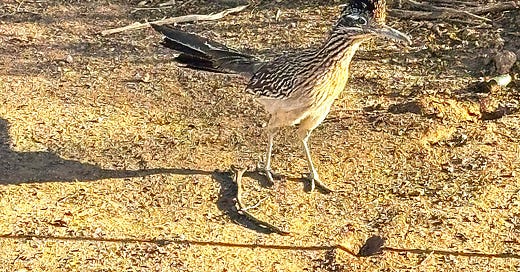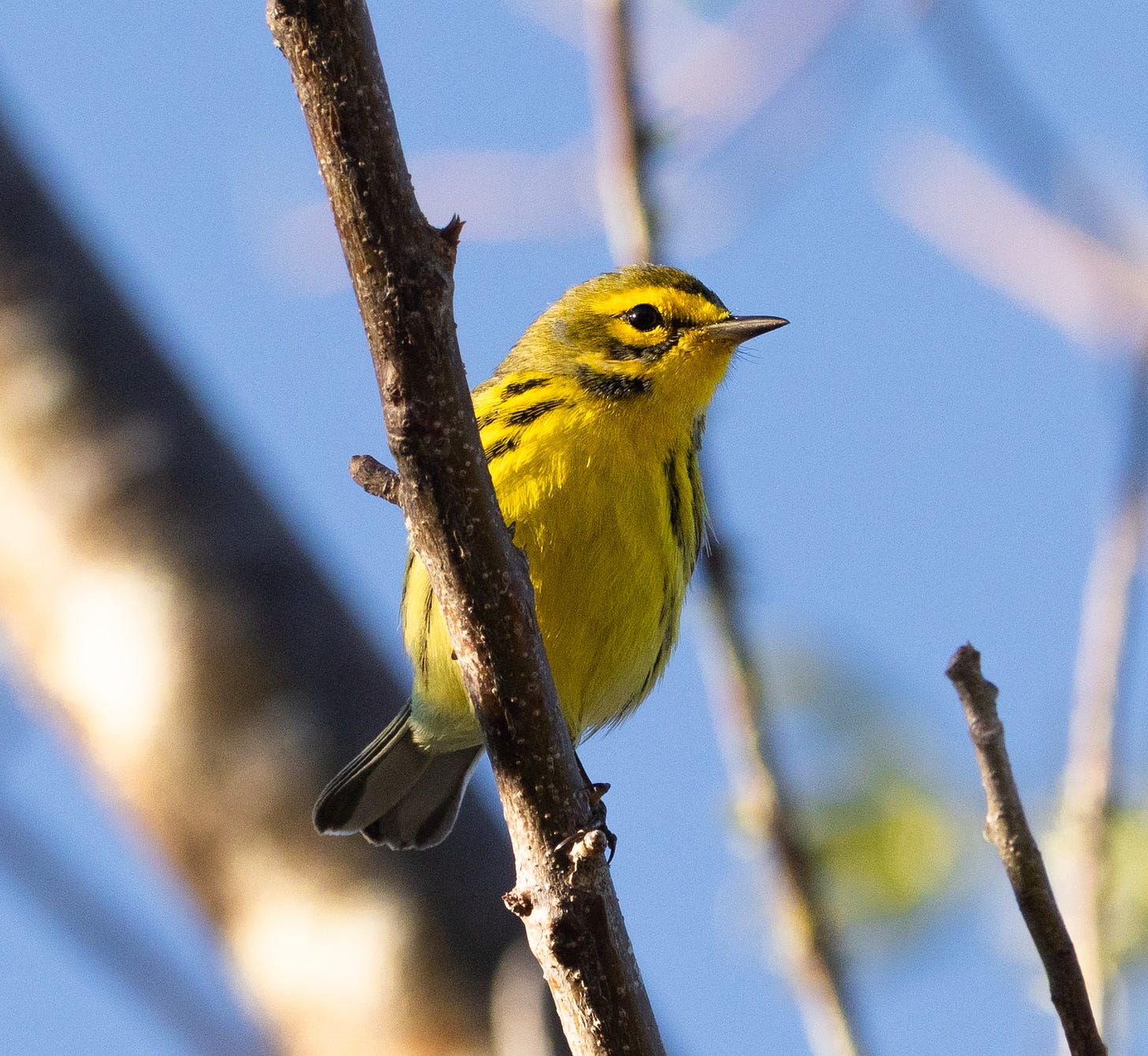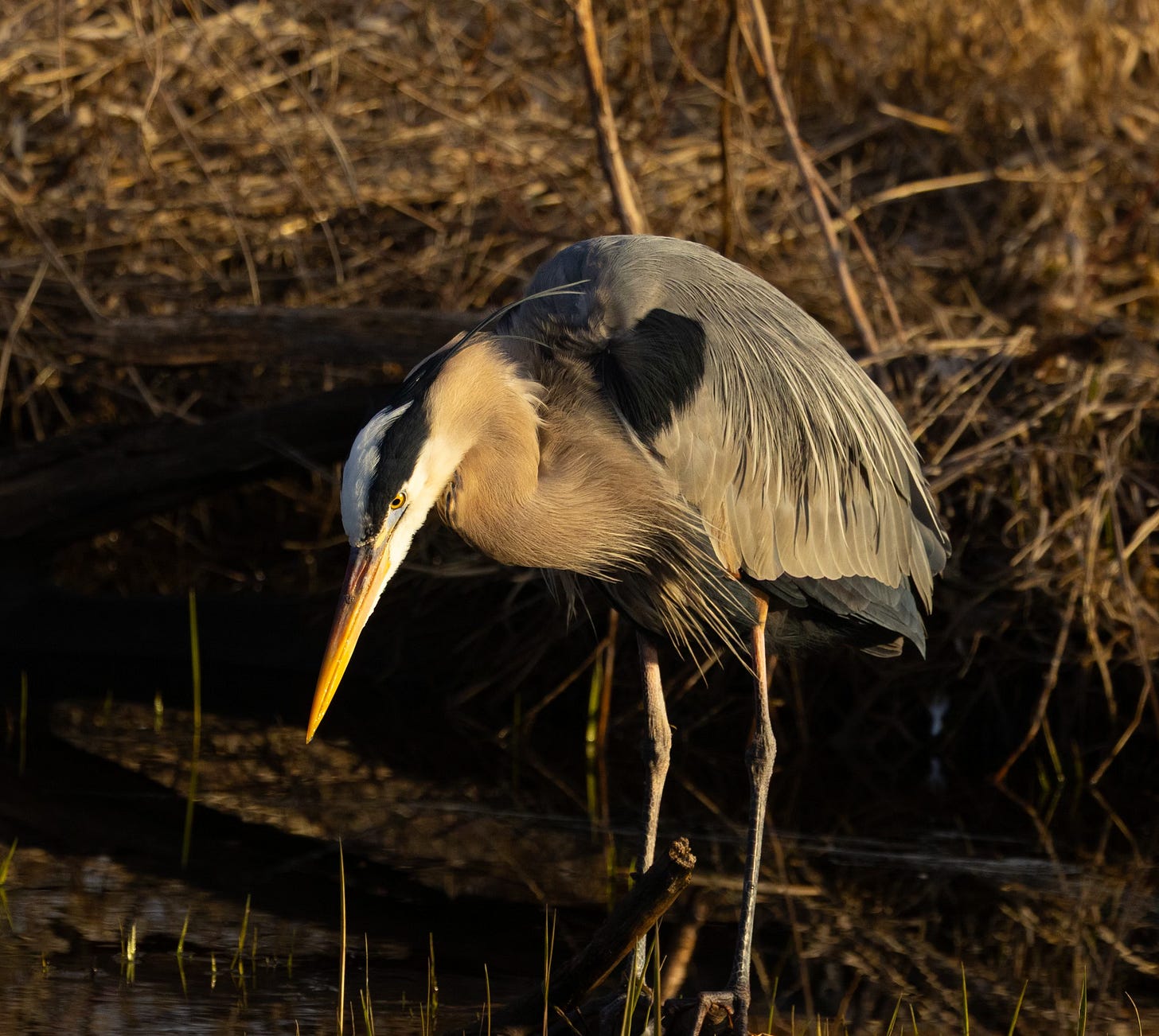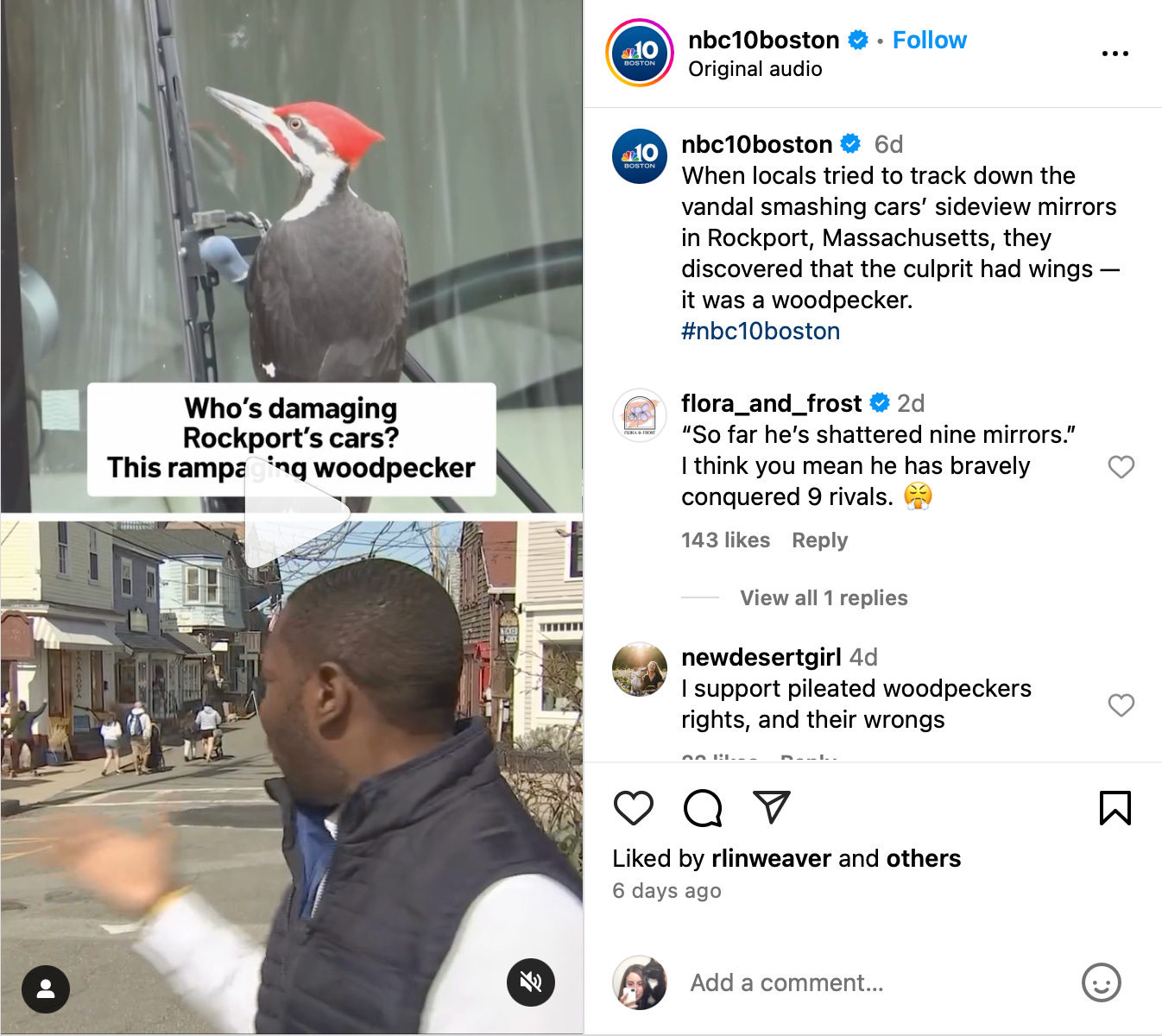1. Let's begin with the release of a 37-year study of the endemic Florida Scrub Jay - "watching evolution in real time": In the scrubby oak landscapes of central Florida, winters are heating up, and Florida Scrub-Jays—those chatty, curious birds endemic to the Sunshine State—are being impacted in unexpected ways. A groundbreaking 37-year study published last October in the journal Ornithology, led by researchers at the Archbold Biological Station in Florida and Cornell Lab of Ornithology, documented a concerning pattern. From 1981 to 2018, the average winter temperature measured at Archbold Biological Station increased by 2.5°F. These warmer winters resulted in Florida Scrub-Jays now nesting one week earlier than they did in 1981, according to scientists. (via Living Bird Magazine)
2. 1.5 million nesting sea birds and ...wait! ...two landing pads for SpaceX rockets? Read on: The U.S. military is seeking to turn a remote Pacific wildlife refuge into a landing site for SpaceX rockets, a move that could ultimately advance military capabilities but could also threaten a rare sanctuary for 1.5 million birds. The U.S. Space Force last month announced its intention to build two landing pads on Johnston Atoll, an unincorporated U.S. territory consisting of four tiny islands about 800 miles southwest of Honolulu. Although the notice of intent did not mention SpaceX, vehicles from Elon Musk’s rocket company would be used for the project, according to a government official familiar with the proposal who spoke on the condition of anonymity because they were not authorized to discuss it. (via The Washington Post)
Pictures From Friends - Christopher Ellis, Greater Roadrunner - Scottsdale, AZ.
3. "How is it possible?" - an interesting article in Quanta on avian intelligence: Humans tend to put our own intelligence on a pedestal. Our brains can do math, employ logic, explore abstractions and think critically. But we can’t claim a monopoly on thought. Among a variety of nonhuman species known to display intelligent behavior, birds have been shown time and again to have advanced cognitive abilities. Ravens plan for the future, crows count and use tools, cockatoos open and pillage booby-trapped garbage cans, and chickadees keep track of tens of thousands of seeds caged across a landscape. Notably, birds achieve such feats with brains that look completely different from ours: They’re smaller and lack the highly organized structures that scientists associate with mammalian intelligence. (via Quanta Magazine)
4. This year's crime story (so far); "...what a person with a bank account and a computer can do...": The roseate spoonbill is not native to New York. But on Wednesday, the tall, pink-winged creature appeared in Brooklyn federal court. The Uruguayan bird, dead and stuffed, perched in front of prosecutors as its former owner, John Waldrop, was sentenced to three years of probation for illegally importing it along with hundreds of other items of taxidermy and thousands of eggs. Mr. Waldrop, a Georgia orthopedic surgeon, was also ordered by Judge Rachel P. Kovner to pay a $900,000 fine for importing the mounted birds, many of which were rare. For more than four years, Mr. Waldrop, with the help of his property’s caretaker, illegally imported hundreds of rare birds and eggs to adorn the interior of his lake house in Cataula, Ga. His makeshift museum featured roughly as many stuffed birds as there are people in Cataula, a town of around 1,400 outside Columbus. (via The New York Times)
5. For us seabird lovers, we hate to see stories like this: The arrows for Norwegian seabird populations are pointing downward. Researchers have now recorded mercury levels above the threshold for effects in seabirds that live on Svalbard. "We don't know what effect this has on the population level, but we know that mercury affects reproduction, behavior and survival," says Silje Lundgren, from NTNU's Department of Biology. Mercury is toxic to both humans and animals, even in small concentrations. It affects the hormonal and immune systems and can cause damage to the nervous system. (via Phys Org)
6. A concerning look at Osprey nest failures on Chesapeake Bay: For Bryan Watts, the Chesapeake Bay’s thriving Osprey population provided a rare ray of hope in his four decades of work as a conservation scientist. The local population crashed during the 1960s and ’70s due to the widespread spraying of DDT and other pesticides, but it began to rebound in the 1980s and ’90s, a recovery documented in surveys conducted by local scientists. By 2020, over 10,000 breeding pairs of the fish-eating raptors called the Chesapeake home. Which is why Watts, who is director of the Center for Conservation Biology at The College of William & Mary, was shocked when he noticed Osprey nests along the main spine of the Chesapeake Bay in Virginia and Maryland were failing. Something, he reasoned, must be wrong. It was. (via Living Bird Magazine)
Pictures From Friends - Donna Robinson, Snowy Owl - Prouts Neck, ME.
7. Why the "dawn chorus"? NatGeo explores: As spring begins, so does a fresh song at daybreak, unique to the season. Just before the sun rises, birds start singing their melodies, creating a chirpy symphony. This phenomenon is known as the dawn chorus, and it’s special for a number of reasons: There are more birds singing at this time of year, and they also sing more often. This energetic burst of birdsong is often louder than usual too. The dawn chorus’ early morning explosion of sounds has even inspired multiple poems and songs. “It's the epitome of spring,” says Jordan E. Rutter, an ornithologist at the American Bird Conservancy. After the long and cold winter, “all of a sudden you have this influx of so many beautiful birds coming back and singing.” (via National Geographic)
8. Warbler primer - A nice piece from a favorite birder/columnist: You’re never too old to learn about birds — and humility. I just completed an online course from the Cornell Lab of Ornithology, entitled “Be A Better Birder: Warbler Identification.” The Lab offers an extensive catalog of skill improvement webinars at Academy.AllAboutBirds.org. Some focus on birding basics. Others are appropriate for more experienced birders. There’s even a separate page of free learning games for kids. I chose warblers as my first course, because I was curious to see if there was anything in the lesson I didn’t already know. Arrogant attitude, I realize. I opened the lesson and promptly misidentified the first bird I saw. If you repeat this to anyone, I’ll deny it. I must say, it was the most comprehensive and complete review of warbler identification I’ve ever seen. (via Bangor Daily News)
* Here's the link referenced (again): Bird Academy | The Cornell Lab | Courses Tutorials Videos
9. There is the old Birds & Bees, and then there is this Bird that actually eats bees: Few animals can stand their ground against a swarm of angry bees, but this crested honey buzzard appears unperturbed. Although the bird belongs to the same family as flesh-eating kites, hawks, and eagles, its main food is bee and wasp pupae and larvae—the developing brood found inside the insects’ nests. When the buzzards encounter a colony of honeybees—as in the image above, captured by photographer Staffan Widstrand in western Taiwan—they will lunch on honeycombs, too. Crested honey buzzards (Pernis ptilorhynchus) can feed on enraged, stinging insects thanks to a number of adaptations. (via Nautilus)
By Hap Ellis, Prairie Warbler - Durante Park, Longboat Key, FL.
10. Haikuboxes, BirdNET and a solar "obscuration" (aka eclipse) - what we learned: Based on anecdotal evidence and research involving human observation and community science, radar analyses, and acoustical studies, birds are thought to stop singing and engage in nighttime behaviors such as roosting during a total solar eclipse. However, these research methodologies are limited by small sample sizes, potential effects of human observation altering birds’ behaviors, and biases in human-recorded findings. Here we show how a community science network of bioacoustics devices using machine learning revealed a decrease in bird vocalization across North America at sites which experienced more than 99% maximum solar obscuration during the total solar eclipse on April 8, 2024. There was variability between sites in bird vocalization responses to a solar eclipse after controlling for human presence. (via Nature)
11. Concerning but maybe not surprising study results: New research suggests conservation efforts could more effectively identify and protect bird species at greatest risk from climate change by better understanding the range of specific conditions they need to thrive. The study, led by the University of East Anglia (UEA), examined the relationship between the extent of the climatic conditions that species tolerate and in which populations can survive—known as climatic niche breadth—and their likelihood of declining in response to climate change. For species inhabiting a similar area of geographic space, those able to tolerate a wider range of climate conditions are less likely to experience population declines, and are more likely to be increasing, compared to those with narrower climatic preferences. (via Phys Org)
12. Max Plank Institute on plumage color as a predictor...of what you ask? Read on: Urbanization has a huge impact on the ecosystem and poses enormous challenges to animals and plants. The ongoing, worldwide increase in urbanization is considered one of the main causes of the steady decline in biodiversity. Urban ecology is the field of research that focuses on the effects of urbanization on different organisms. For example, many studies have investigated how urban noise affects communication in birds. However, little is still known about the relationship between urbanization and plumage colour in birds. (via EurekaAlert)
13. (Good) Avian flu news from the MIT Technology Review: Over the winter, eggs suddenly became all but impossible to buy. As a bird flu outbreak rippled through dairy and poultry farms, grocery stores struggled to keep them on shelves. The shortages and record-high prices in February raised costs dramatically for restaurants and bakeries and led some shoppers to skip the breakfast staple entirely. But a team based at Washington University in St. Louis has developed a device that could help slow future outbreaks by detecting bird flu in air samples in just five minutes. The new device samples the air in real time, running the samples past a specialized biosensor every five minutes. The sensor has strands of genetic material called aptamers that were used to bind specifically to the virus. When that happens, it creates a detectable electrical change. The research, published in ACS Sensors in February, may help farmers contain future outbreaks. (via MIT Technology Review)
14. Travel news - A gateway to a (birding) paradise: The first thing that strikes you about Shanghai is how quiet, clean and efficient a city it is. Strike out preconceptions of congestion, pollution and chaos. Think Swiss efficiency, German green standards and all in a city of towering buildings and a vast population almost three times that of London. Even in the most built-up area, traffic was so sparse and silent it was possible to hear Chinese blackbirds, spotted doves and bulbuls calling from the street trees. Shanghai has a public transport system we can only dream of: a comprehensive, efficient and very cheap metro. The main railway station has 13 platforms serving an astonishing and fast-expanding high-speed train network. We took the metro from the city to its terminus to meet our expert guide from Shanghai Birding, Chloe Kan. A quick ride southwest and we reached the Nanhui promontory, where the mighty Yangtze meets the sea. (via The Times)
By Hap Ellis, Great Blue Heron - Millennium Park, Boston, MA.
15. There is the Rose Bowl, the Super Bowl and ...the Nebraska Birding Bowl! With 4 categories no less: Participate in the third Nebraska Birding Bowl and learn about birds, enjoy the outdoors and contribute data toward bird conservation. This fun, free statewide competition is returning this May for Nebraska Bird Month. The Birding Bowl is a great opportunity to try out this fun hobby, improve skills, and share your love of birding with others. Birding opportunities exist across the state. Participants of all experience levels are invited. Birders can compete as individuals or teams, registering online in April or May. They may participate in one of the following categories:
Fledgling Flock — for youth groups and families to introduce birding to youth.
Backyard Birder — for households that enjoy watching birds from their home.
Dabbling Birder — for beginner-to-casual birders.
Competitive Birder — for those who like to observe the most bird species.
Birders will use eBird, a community science platform, to track observations while contributing data for bird conservation. Teams have a chance to win prizes, such as Vortex binoculars and a $1,000 cash prize. (via KCSR News)
16. Speaking of contests, BirdLife Australia had its annual "Aussie Bird Count” last October. 57,000 birders and 4.1 million birds counted; and the most common? The Rainbow Lorikeet: The rainbow lorikeet and its colourful plumage has topped Australia’s largest citizen science event as the most numerous bird recorded across the country. More than 4.1m birds were counted as part of BirdLife Australia’s annual Aussie Bird Count, a week-long event which involved 57,000 participants across the country last October. The vibrant rainbow lorikeet has reigned supreme atop the count since it began in 2014 (via The Guardian)
* Check out the winner here: Rainbow Lorikeet - Trichoglossus moluccanus - Birds of the World
17. Finally, A quick feel-good story about a boy and his 50 birds songs: Eleven-year-old Samuel Henderson of Choctaw, Oklahoma, is a born entertainer with a unique talent: he can perfectly imitate about 50 birds. "Some people say that I swallowed birds," Henderson, who is autistic and has Tourette syndrome, told CBS News. He says the most difficult bird to emulate is the barn swallow, but he can imitate anything from a blue jay and a tufted titmouse to a robin. Since Henderson mostly practiced his calls alone on the playground along the back fence, many kids at his school had not ever heard his incredible skills. That is, until the annual 2024 Nicoma Park Intermediate School talent show. (via CBS News)
Go Birding!
Bird Videos of the Week
Bryant Park NYC - Timberdoodles touch down.
NBC 10 Boston - The Culprit has Wings.
Accuweather - Braving the Storm
Cornell Live Bird Cam - Barred Owl Chicks!
Cornell Live Bird Cam - Athena’s Owlet!











